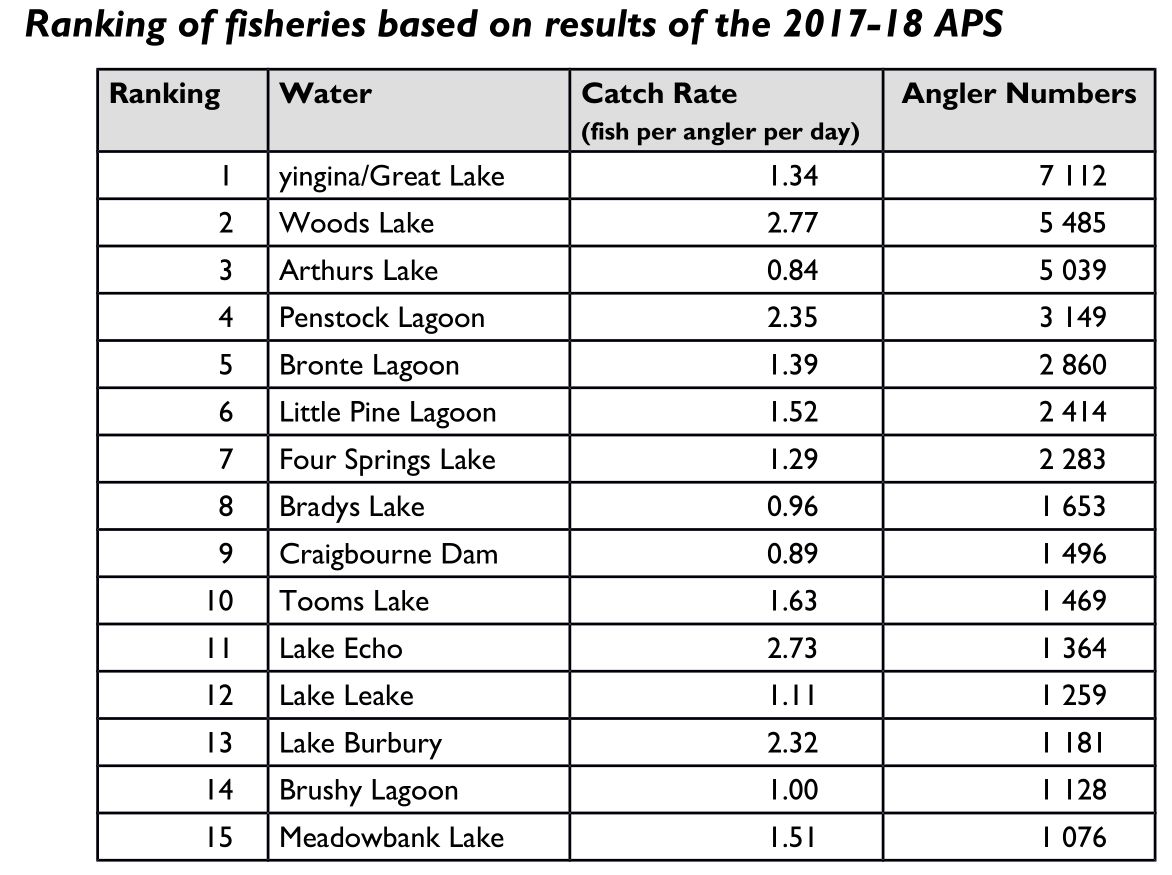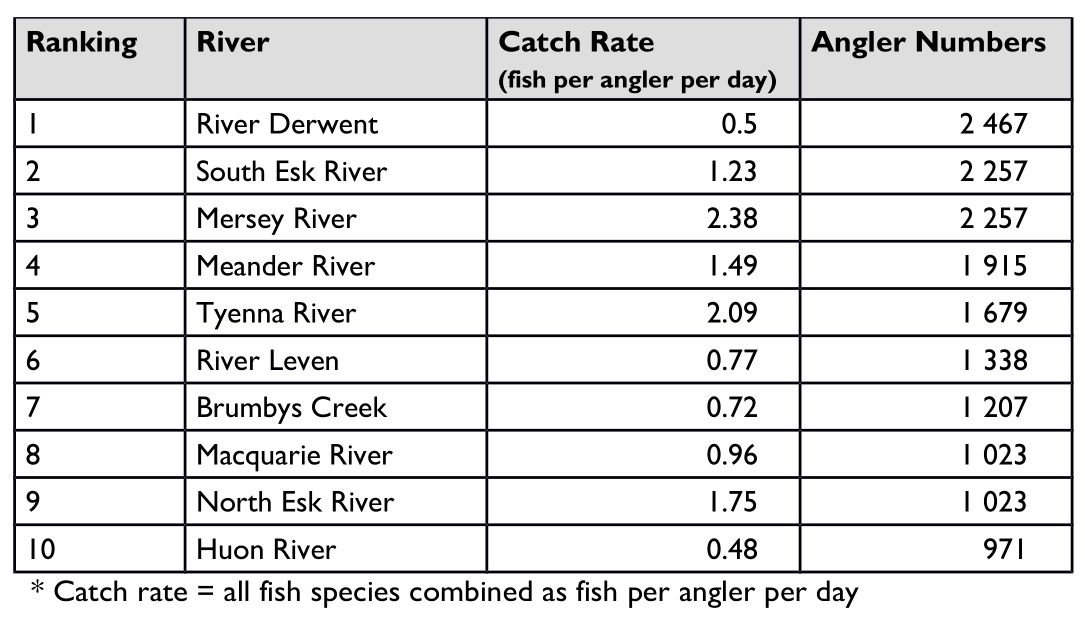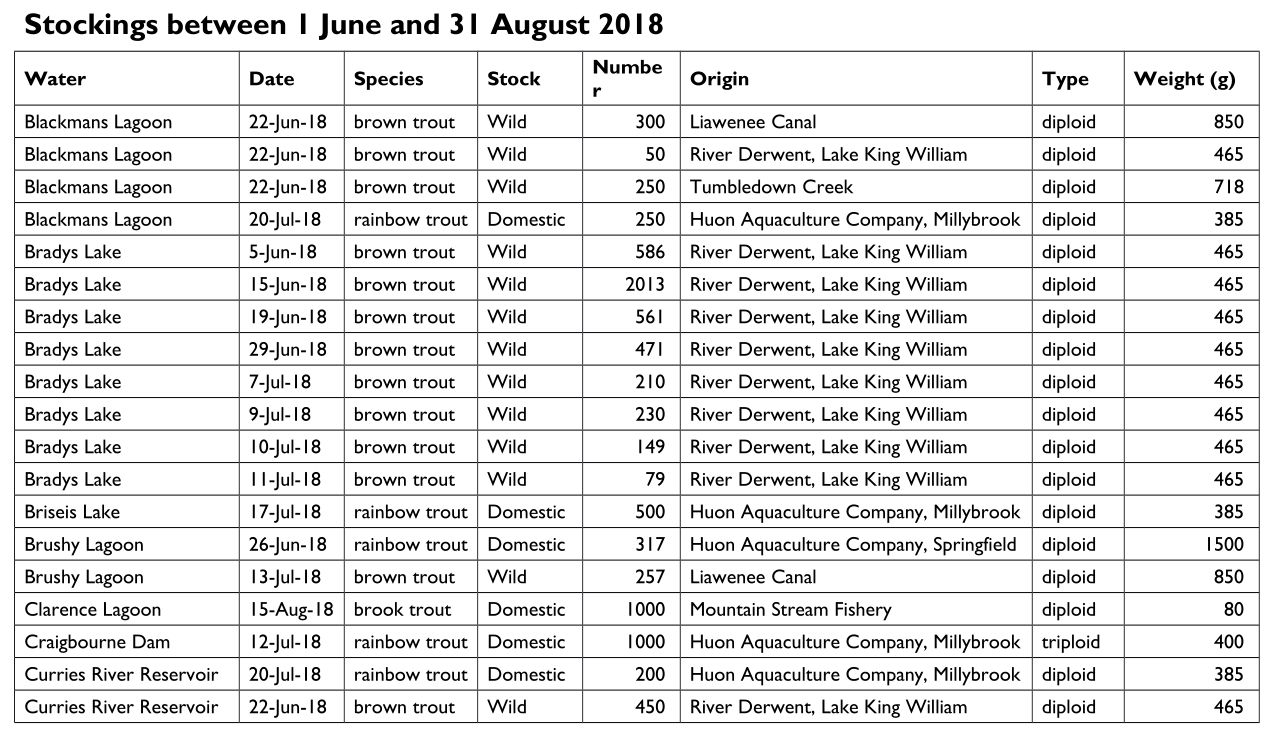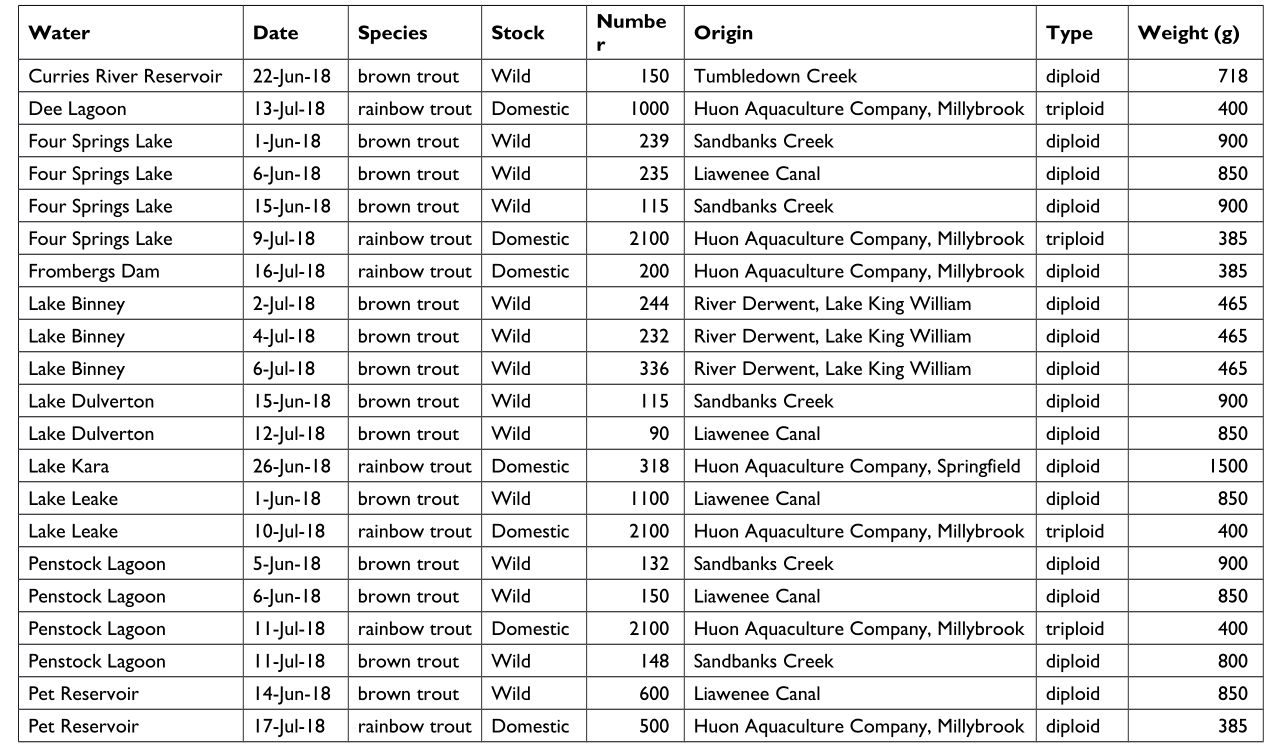In accordance with the Tasmanian Inland Recreational Fishery Management Plan 2018-28, two fishery assessments have been identified for 2018-19, Woods Lake and Bronte Lagoon. We also plan to undertake a follow up survey of Shannon Lagoon following the release of 500- tagged fish in June 2017.
Anglers surveys
Angler surveys We conduct the annual Angler Postal Survey (APS) to get measurable information on recreational fishery each year. We mail a written questionnaire at the end of the season to a sample of licence holders.
There is a summary of the top ten rivers and top ten lakes and lagoons below. A full report of the Angler Postal Survey (APS) results for the 2017-18 will be published on the IFS website during September 2018.


Ranking of fisheries based on results of the 2017-18 APS
* Catch rate = all fish species combined as fish per angler per day
The 2018 brown trout spawning run
Monitoring
During the spawning run, we sampled the fish from the traps at yingina/Great Lake, Arthurs Lake and River Derwent above Lake King William. We do this to get the average weight and length of the brown trout.

The average length and weight of the fish at yingina/Great Lake decreased for 2018 compared with 2017. The average weight of brown trout at Liawenee Canal fell by 157 grams and at Sandbanks Creek, the weight fell by 86 grams. At Arthurs Lake, the number of fish in the traps over 400 mm in length increased from 43% in 2017 to 62% in 2018. We continued to release all fish over 400 mm above the traps to spawn. The River Derwent trap above Lake King William showed an increase of in average weight by 87 grams and an increase in average length of 35 mm.
Adult brown trout transfers
The brown trout spawning migration is complete across all the traps in the Central Highlands and so is the annual transfer of wild adult brown trout. Sometimes natural recruitment cannot sustain a wild population. We assist these fisheries with stocking using wild fish whenever possible. Total number of wild adult brown trout stocked from all traps during the 2018 spawning run was 25 808.
Waters stocked with wild adult brown trout include:
Blackman’s Lagoon 600
Bradys Lake 7 774
Craigbourne Dam 1 100
Curries River Reservoir 600
Four Springs Lake 4 039
Lake Binney 2 248
Lake Crescent 2 000
Lake Dulverton 115
Lake Leake 1 100
Penstock Lagoon 3 150
Lake Leake 1 100
Pet Reservoir 600
South Riana Dam 400
Tooms Lake 1 000
Seasonal spawning migration numbers
Brown trout
From the Liawenee Canal (yingina/Great Lake) fish trap we transferred over 13 000 wild adult brown trout. From Sandbanks Creek, (also yingina/Great Lake), 1 554. From the River Derwent (Lake King William) we transferred just over 9 000. Most of these we stocked in to the Bradys Chain of lakes. From the three fish traps on Arthurs Lake we trapped 8 606 wild adult brown trout but transferred only 1 416 fish. All fish over 400 mm were released above the trap to continue on their spawning migration.
Rainbow trout
Rainbow trout stockings started on the 26 June 2018 with 12 785 stocked into the public fisheries.
- Blackmans Lagoon 250
- Briseis Lake 500
- Brushy Lagoon 317
- Craigbourne Dam 1 000
- Curries River Reservoir 200
- Dee Lagoon 1 000
- Four Springs Lake 2 100
- Frombergs Dam. 200
- Lake Kara 318
- Lake Leake 2 100
- Penstock Lagoon 1000
- Pet Reservoir 500
- Pioneer Lake 500
- Taylors Dam 200
- Tooms Lake 1 500
Carp Management Program
Throughout the winter period, maintenance was done at Lake Sorell ready for the peak carp spawning season (October to February). This involved checking and repairing the 14 kilometres of barrier netting used to stop carp from getting into their wetland spawning sites. Gillnet was also repaired in anticipation of warming waters and rain events. A shipment of 60 new trammel nets were ordered from the UK, which will be due to arrive in September. Fishing effort was maintained on a small scale, and was dependant on weather conditions. The two remaining transmitter fish remained spread across the lake, sitting in the same locations for weeks at a time. Gill nets were set in a range of spots, targeting both tracker fish as well as rocky reef structures in deep water (2m +). Two carp were caught, one in a non-targeted gill net set over a rocky reef, and another which was caught while targeting a transmitter fish. In mid-July, Jonah Yick, IFS Leader of the
Tasmanian Carp Management Program attended a workshop in Canberra. The workshop was part of a larger project under the National Carp Control Plan (NCCP). At the workshop there were specialists from all over the country including:
-> researchers of small and large fish,
->plant scientists,
-> waterbird scientists,
-> amphibian (frogs and toads) researchers, and
-> bug scientists.
The workshop discussed how different levels of carp reduction from mainland waterways might affect the surrounding ecosystem. It also talked about water quality, system modelling, risk analysis, and economics.
Hopefully, the outcome of the workshop will assist the NCCP to: -> plan an integrated approach to controlling carp in Australia’s waterways, -> understand and manage the risks involved with the removal of carp, -> quantify the benefit/cost analysis of the project, and -> inform stakeholder engagement. For more information about the National Carp Control Plan, see http://www.carp.gov.au/
Legislation The introduction of the Tasmanian Inland Recreational Fishery Management Plan 2018-28 in June required amendments to the Inland Fisheries (Recreational Fishing) Regulations 2009 and the Inland Fisheries (Seasons and Waters) Order 1996. NOTE: under the Inland Fisheries Act 1995 “salmon” includes brown trout, brook trout, rainbow trout and Atlantic salmon.
The following amendments were made for the 2018-19 angling season:
-> changes to the interpretation section of the regulations to support the application of daily bag limits, define waters reserved for juvenile anglers and update species nomenclature; -> amended wording so minimum size limits are specifically applied to inland and excepted waters;
-> a 220 mm minimum size limit for “salmon” for all rivers and wild and over populated fisheries;
-> a 400 mm minimum size limit for “salmon” taken from Bruisers Lagoon, Camerons Lagoon, Lake Crescent and Penstock Lagoon, and omit the 420 mm size limit for Penstock Lagoon;
-> a 300 mm minimum size limit for “salmon” for lakes generally;
-> removal of the specific size limit reference for brown trout for yingina/Great Lake;
-> a daily bag limit of two “salmon” that are greater than 500 mm in length for specific waters as listed under the new Schedule 6 of the regulations;
-> a daily bag limit of one “salmon” that is greater than 500 mm in length for Bruisers Lagoon, Camerons Lagoon, Lake Crescent, Penstock Lagoon and any Junior Angling Development fishery;
-> a separate daily bag limit of 12 fish for either “salmon” or blackfish;
-> a specific daily bag limit of two “salmon” while fishing in a junior angling development fishery;
-> a specific daily bag limit of five “salmon” for any river;
-> a daily bag limit of two brook trout or five Atlantic salmon for all inland waters;
-> new bag limit regulations to be applied the same as current bag limits, i.e. to allow anglers to continue to fish once the daily bag limit has been reached, provided all subsequent fish are returned;
-> amended fishing methods to allow anglers to use bait while fishing at Huntsman Lake;
-> a new schedule inserted (Schedule 2) that prescribes waters reserved for juvenile angling and redefines the age of a juvenile angler as a person under 18 years of age;
-> an update to Schedule 4 – Infringement Notice Offences, to include current amendments;
-> an update to Schedule 5 – Bag Limits, to include new waters and changes to new bag limits;
-> a new schedule inserted (Schedule 6 – Daily Bag Limits) and waters listed that apply under regulation 17(1) i.e. allowing only two “salmon” over 500 mm length;
-> minor administrative matters amended relating to: correcting nomenclature, removing obsolete references and updating matters primarily relating to the issuing of infringement notices and updating the numbering of specific regulations; and Page 25 of 31
-> moved the seasonal boundary on the River Leven to Whisky Creek and the River Derwent to New Norfolk Bridge, to provide for an extension of all year round waters on these rivers. Amendments were made to the Inland Fisheries (Commercial Net and Fees) Regulations 2009:
-> renamed as the Inland Fisheries (General) Regulations 2009; and
-> added a Schedule 2 – Infringement Notice Offences and Penalties, allowing an infringement notice to be issued for prescribed offences under the Inland Fisheries Act 1995.
Legislation Review 2019
The Inland Fisheries (Recreational Fishing) Regulations 2009 and the Inland Fisheries (General) Regulations 2009 (formerly the Commercial Nets and Fees Regulations 2009) are due for review and remake by December 2019.
Regulations are reviewed every 10 years. This ensures that legislation made is effective, efficient and necessary and that, in cases where it imposes a cost or burden on the Tasmanian community, it is justified as being in the public interest. It is also ensures outdated or inappropriate subordinate legislation is not kept indefinitely.
The IFS will soon begin reviewing these two regulations. For the recreational fishery, this should be a straightforward process, as we have recently reviewed our regulations for the trout fishery under the Tasmanian Inland Recreational Fishery Management Plan 2018-28. For the commercial freshwater fishery and associated industries, it is envisaged that some significant changes may be required to meet the contemporary management of activities. Interested stakeholders will be able to offer comment on this legislation when a Regulatory Impact Statement is released for public comment mid-2019.
The IFS is also reviewing the Seaward Limits Order that defines the boundaries between Inland and State (marine) waters. We hope to complete this by the start of the 2019-20 angling season.
Compliance
Following up intelligence leads was critical to the success of joint operations during the year. With Tasmania Police, we carried out operations to enforce whitebait regulations on waters in the North West, successfully laying charges for fisheries and non-fisheries offences. The cooperation benefited all enforcement agencies involved, and the operations led to the conviction of nine defendants for 34 whitebait and related offences, with fines of $26 394. Seven further defendants are pending appearance in the Magistrates Court on 33 charges.
Analysis of data showed the waters in the State with the largest number of recorded fisheries offences were River Derwent, Woods Lake, yingina/Great Lake, Craigbourne Dam, St Patricks River, Arthurs Lake, Lake Duncan, Penstock Lagoon and Dee Lagoon. All had five or more infringement notices issued in 2017-18.
Statistics from 1/7/17 to 30/6/18
-> 4 455 angling and 241 whitebait licences inspected.
-> 28 nets seized.
-> 46.9 kilograms of whitebait seized.
-> Six search warrants executed and two searches by consent of residential premises.
-> Five vehicles and one vessel searched.
-> 602 vessels inspected under Marine and Safety legislation.
-> Nine defendants convicted of 34 offences in the Magistrates Court with seven further defendants listed for appearance on 33 charges.
-> Infringement and Conditional Cautions issued for 179 offences.
-> $15 443 in court fines and $26 394 in infringement notice fines.
-> Eleven notices of disqualification are current, preventing offenders from holding a recreational whitebait licence.
Prosecution Offences June to August 2018
-> Paul Liam J J NICHOLS of Mella was convicted on 6/6/18 in the Smithton Magistrates Court of 1 count of Take whitebait without a whitebait licence, 1 count of Possess whitebait without a whitebait licence, 1 count of Fail to comply with a Ministerial order under the Inland Fisheries Act 1995 relating to the taking of whitebait, 2 counts of Use net other than landing net or seine net at inland waters and 2 counts of Possess net other than landing net or seine net at inland waters. The defendant was fined $3,000 and court costs of $82.15.
-> Peter Morris SALTER of Montagu was convicted on 20/8/18 in the Burnie Magistrates Court of 3 counts of inducing another person to commit an offence under the Inland Fisheries Act 1995. The charges relate to his part in transporting Brodie Lee POPOWSKI to the Montague River so he could illegally fish for whitebait. The Defendant was fined $700 and court costs of Page 27 of 31 $83.74. These offences will appear in the 2018/19 ‘Prosecution Offences’ table, on the next occasion.
-> Paul Charles BAKES OF Hampshire was convicted on 20/8/18 in the Burnie Magistrates Court of 6 counts of take protected fish, 9 counts of possess freshwater crayfish and 1 count of take trout without a licence. Information from the public resulted in a joint operation between IFS Fisheries Officers and Marine Police at Stanley. Mr Bakes admitted the offences and was charged. The complaint outlined the Defendant illegally hunted, caught and ate the highly protected and threatened species from November 2013 to November 2017. The Defendant was fined $8550 and court costs of $66.36. These offences will appear in the 2018/19 ‘Prosecution Offences’ table, on the next occasion. Club events, meetings and dinners June 2018 -> Southern Tasmanian Licenced Anglers Association annual general meeting and dinner -> Longford Anglers annual dinner July 2018
-> New Norfolk Licenced Anglers Association annual dinner -> North Western Fisheries Association annual general meeting -> Tasmanian Fly Tyers annual dinner August 2018 -> Devonport Anglers Association – Presentation Day and Junior Angling Day -> Talk Wild Trout -> Corra Linn Fly Fishers Club Presentation -> Australian Stram Management Conference Hobart
Stockings between 1 June and 31 August 2018







